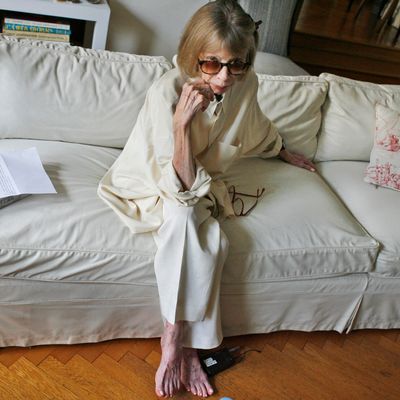
You’ve probably heard about Joan Didion’s packing list. Two skirts; one sweater. Cigarettes and bourbon. A mohair throw. A typewriter. It goes on. When she died on Thursday at the age of 87, this list, which she kept taped to her closet door, came up a lot — both in reverence and with an eye roll. Some people think it’s perfect; a model of personal taste that is both disciplined and self-indulgent. Others think it’s a bit overhyped. (Deodorant? Duh.) Or that maybe we should focus on Didion’s talents beyond filling a suitcase. There are lots of opinions out there, but I’d completely forgotten about it until I logged on to Twitter earlier today and saw screenshots and comments to the effect of: Don’t you dare bring it up. (Which is, of course, one way of bringing it up. Again.)
If you’ll allow me to linger on it for just one second longer, though — hey, you brought it up! — to me, our enduring fixation with Didion’s packing list has less to do with its contents and more to do with the fact that we crave decisiveness. Unsentimental, uninfluenced decisiveness. It is emblematic of a woman who carefully considered every choice she made, whether it was a word on a page or a sweater in a suitcase, and who was driven exclusively by her own sensibility, no one else’s. She found power in restraint. She was a human black turtleneck. And so we co-sign her packing list (or say we’re above it) as a way to signal that we, too, know how to make good choices. That we, too, have good taste. Despite the fact that Didion herself would probably see that as an empty gesture.
The irony is that it’s impossible, I think, to identify any sense of style from the contents of this packing list. Didion herself acknowledges that it was not meant to demonstrate a sense of identity but rather a lack thereof. “The list enabled me to pack, without thinking, for any piece I was likely to do,” she explains. “Notice the deliberate anonymity of costume: in a skirt, a leotard and stockings, I could pass on either side of the culture.”
As someone whose career involved observing the stylistic choices and predilections of others, Didion had a sharp awareness of her own image as well. “It should be clear that this was a list made by someone who prized control, yearned after momentum, someone determined to play her role as if she had the script, heard her cues, knew the narrative,” she continues. Her uniform of above-it-all minimalism and icy Hollywood reserve seemed to serve as something of a costume — a tool countless public figures before and after her have used as a way to create distance. (Anna Wintour being one of them. The Olsens, too.) Which is perhaps why so many yearn to try it on themselves.
When I sat down today to write about Didion’s style, I wasn’t sure where to start. The long, loose dress and flip-flops — so California. The ridiculously cool Gap and Celine ads. The innocent hair clips. The sunglasses people paid thousands of dollars to get their hands on. Clearly, she had great taste and a point of view. But was it that remarkable? I’m not so sure. (And neither was the list, which I kept coming back to because Twitter wouldn’t let me forget it.) That was maybe the goal, though: The choices themselves mattered less than the fact that she made choices, confidently, and stuck with them. If they weren’t for you, well, too bad.
More than any one look, I think people are obsessed with what Joan Didion wore (and packed) because she was a smart, practical woman who acknowledged that these stylistic choices, however small, mattered. That fashion is important because it’s how we communicate who we are, even if it’s just to ourselves. “Remember what it was to be me,” she wrote of keeping a notebook. “That is always the point.”





